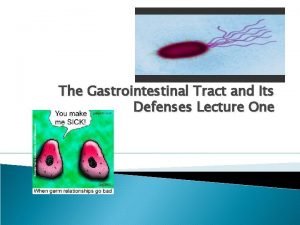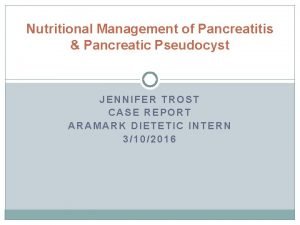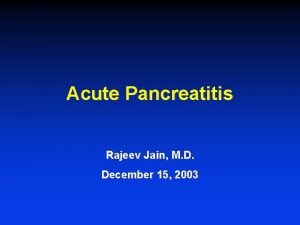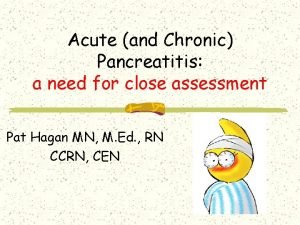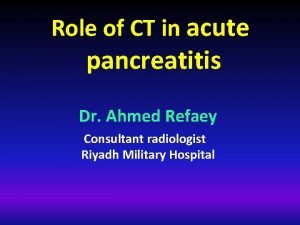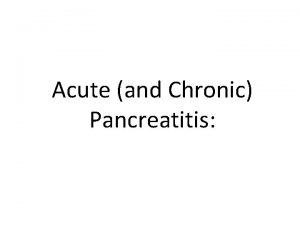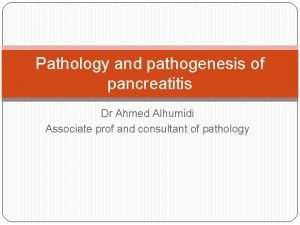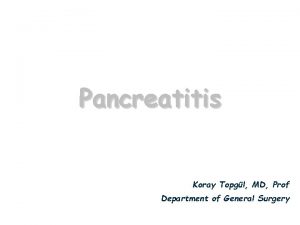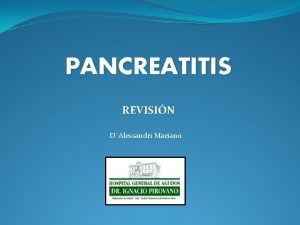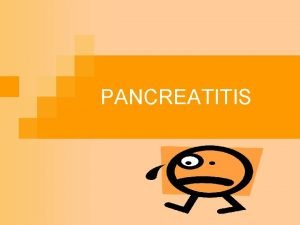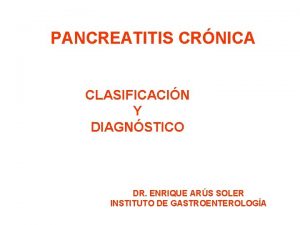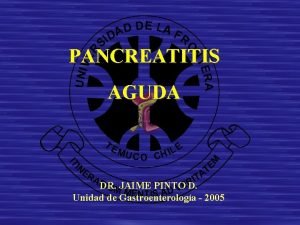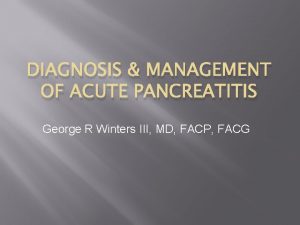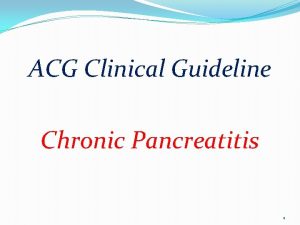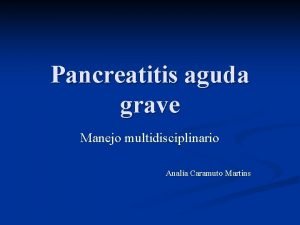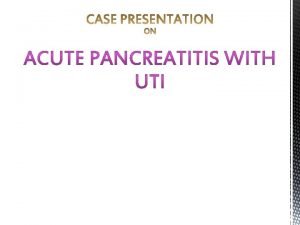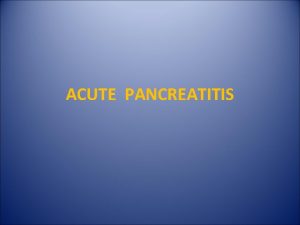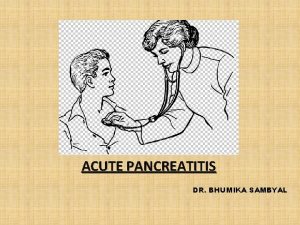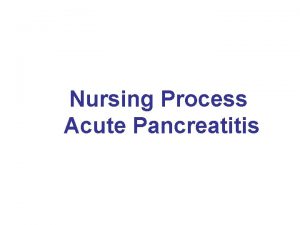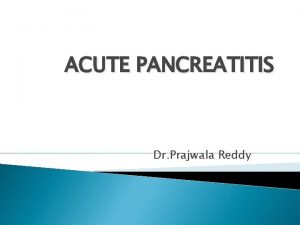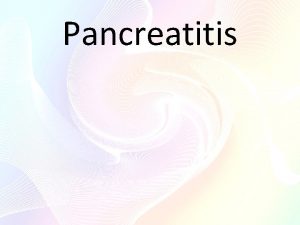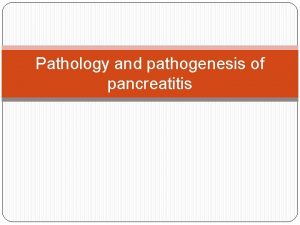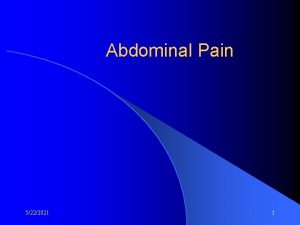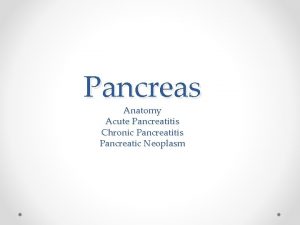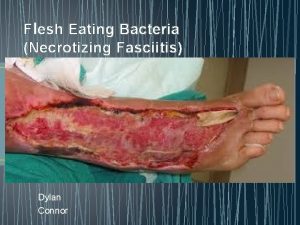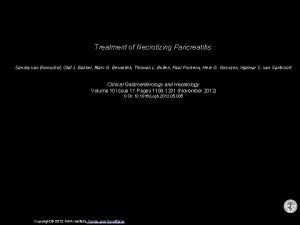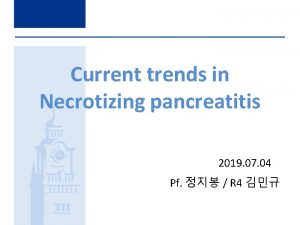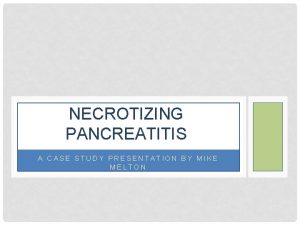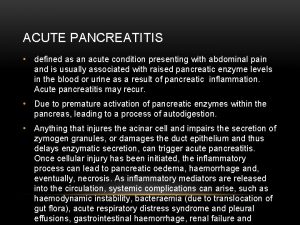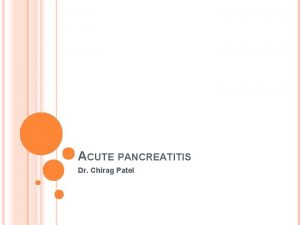Management of Acute Necrotizing Pancreatitis Dr Joyce WT





























- Slides: 29

Management of Acute Necrotizing Pancreatitis Dr Joyce WT Ng Tseung Kwan O Hospital

Prophylactic antibiotics n ERCP n Nutritional support n Inhibition of pancreatic secretion n Surgical intervention n n Indication n Timing n Modalities

Introduction n Severe pancreatitis n n Acute pancreatitis associated with the presence of organ failure or pancreatic/peri-pancreatic complications, or both Pancreatic necrosis n Diffuse or focal areas of non-viable pancreatic parenchyma, typically associated with peripancreatic fat necrosis A clinically based classification system for acute pancreatitis. Summary of the International Symposium on Acute Pancreatitis, Atlanta, 1992. Bradley EL et al. Arch Surg 1993

Surgical Intervention - Indications - Timing - Modalities

Surgical Intervention - Indications - Timing - Modalities

Indications: Infected Necrosis n Infected pancreatic necrosis is a uniformly accepted indication for surgical intervention Acute Pancreatitis: Who Needs an Operation? Beger HG et la. J Hepatobiliary Pancreat Surg 2002 UK Guidelines for the Management of Acute Pancreatitis UK Working party on Acute Pancreatitis. Gut 2005 Acute Necrotizing Pancreatitis: Treatment Strategy According to the Status of Infection Buchler MW et la. Ann Surg 2000

Indications: Sterile Necrosis n Over 90% of patients with sterile necrosis can be successfully treated without surgical intervention Acute Necrotiziing Pancreatitis: Treatment Strategy According to the Status of Infection. Buchler MW et la. Ann Surg 2000 n Surgical treatment of sterile necrosis appears to have a higher mortality rates (11. 9%, CI: 5. 3 -22. 2) than the conservative treatment (2. 3%, CI: 0. 3 -8. 2) in patients with sterile necrosis Evidence-Based Treatment of Acute Pancreatitis. A look at Established Paradigms. Heinrich S et la. Ann Surg 2006

Indications: Sterile Necrosis n Small group of sterile necrosis still warrants surgical interventions n Deteriorating support condition despite maximal Evidence-Based Treatment of Acute Pancreatitis. A look at Established Paradigms. Heinrich S et la. Ann Surg 2006 JPN Guidelines for the Management of Acute Pancreatitis: Surgical Management Isaji S et la. J Hepatobiliary Pancreat Surg, 2006

Surgical Intervention - Indications - Timing - Modalities

Timing Early versus Late Necrosectomy in Severe Necrotizing Pancreatitis. The American Journal of Surgery 1997 Feb; 173(2): 71 -5. J Mier, E. Leon, A. Castillo, F Robledo, R Blanco n n n First RCT Early (<72 hrs, n=25) Vs Late (>12 days, n=15) Indication: MOF with clinical deterioration despite maximal intensive care Intervention: open packing with staged necrosectomy Mortality: 56% (early) Vs 27% (Late) Prematurely terminated because of very high mortality for early surgery group (odd ratio: 3. 4)

Timing of Surgical Intervention in Necrotizing Pancreatitis Besselink MG et al. Arch Surg 2007 • Systemic review of 11 series • Review of 1136 patients • Only 1 RCT .

Timing n n Not recommended early surgical intervention Late intervention n n Separation of viable from non-viable tissue Reduced bleeding Removal of less normal pancreas Operate on a more hemodynamically stable patient Analysis of the delayed approach to the management of infected pancreatic necrosis. Nilesh D et al. Word J Gastro 2011

Timing However, there was no consensus about the length of time that conservative treatment should be applied before surgical intervention should be considered n It is generalized accepted that at least 3 -4 weeks of conservative management is desirable n JPN Guideline for the Management of Acute Pancreatitis: surgical Management. Isaji S. et al. J Hepatobiliary Pancreat Surg 2006

Surgical Intervention - Indications - Timing - Modalities

Modalities Open necrosectomy n Minimally invasive necrosectomy n n Percutaneous n Endoscopic n Laparoscopic assisted

Open necrosectomy Classical modality over the past decades n Principles: control septic foci n n Debridement of the necrotic tissue n Post-operative lavage: removal of retroperitoneal debris and exudates n Mortality rate: 13 -43% Surgery in the Treatment of Acute Pancreatitis – Open Pancreatic Necrosectomy. Werner J et la. Scand J Surg 2005

Open necrosectomy n 4 principle techniques: 1. 2. 3. 4. Opening packing Planned, staged relaparotomies with repeated lavage Necrosectomy with continuous lavage of the lesser sac and retroperitoneum Necrosectomy with closed packing

Open necrosectomy n Single necrosectomy with postoperative lavage without planned relaparotomies seems to be less harmful n More complications (e. g. fistula, incisional hernia, local bleeding) were seen in repeated laparotomies Surgery in the Treatment of Acute Pancreatitis – Open Pancreatic Necrosectomy. Werner J et la. Scand J Surg 2005 Acute Pancreatitis at the beginning of the 21 st century: The state of the art. Tonsi AF et al. World J Gastroenterol 2009

Minimally Invasive Necrosectomy Developed in recent 2 decades n It is generally accepted to have comparable results with open necrosectomy n No randomized studies for comparison n Approaches: n n Percutanoeus n Endoscopic n Laparoscopic-assisted

1. Percutaneous Necrosectomy n n n An endoscope is inserted into the retroperitoneal space under GA n Utilize CT guided placement of small calibre percutanous drain into retroperitoneum n Mainly over left flank n The tract is then dilated for passage of the scope Remove debris by lavage and piecemeal extraction of necrotic debris Post operative continuous lavage NICE Guideline for Percutaneous Pancreatic Necrosectomy

1. Percutaneous Necrosectomy n Potential advantages: Less postoperative physiological disturbance n Reduced need for intensive care n Fewer complications n n Limitations: May not have feasible route for necrosis in head or uncinate region n May require multiple sessions (subsequent session can be done under LA) n Minimal Access Retroperitoneal Pancreatic Necrosectomy Improvement in Morbidity and Mortality With a Less Invasive Approach. Raraty MGT et la. Ann Surg 2010

2. Endoscopic Necrosectomy n n n Usually under LA with sedation Localize the collection with EUS Transgastric/ transduodenal puncture Tract is dilated and scope enter cavity Necrosectomy under direct vision with irrigation, use of forceps or snares Placement of multiple nasocystic drains for post-operative drainage Peroral Transgastric/ Transduodneal Necrosectomy. Success in the Treatment of Infected Pancreatic Necrosis. Escourrou J et al. Ann Surg 2008

2. Endoscopic Necrosectomy n Potential advantages n n n Comparable results with open necrosectomy Less postoperative physiological disturbance Reduced need for intensive care Providing diagnostic and therapeutic option for biliary pathologies at the same session Limitations n n n Highly skilled experienced interventional endoscopist Transient aggravation of sepsis and hemorrhage Cannot deal with extended necrosis to paracolic gutter Limited ability to evacuate large cavities Multiple sessions were required Peroral Endoscopic Drainage/ Debridement of Walled-off Pancreatic Necrosis. Papachristou GI. Ann Surg 2007

3. Laparoscopic-assisted Necrosectomy 2 -5 ports n +/- hand ports n Mainly with infra colic approach n

3. Laparoscopic- assisted Necrosectomy n Potential advantages n n n Decrease the trigger of systemic cytokinemediated immune response Better exposure Possible complications n n Spreading of infection to infracolic compartments Similar morbidity rate compared with open surgery Laparoscopic-Assisted Pancreatic Necrosectomy. A new Surgical Option for Treatment of Severe Necrotizing Pancreatitis. Parekh D. Arch Surg 2006

A Step-up Approach or Open Necrosectomy for Necrotizing Pancreatitis (PANTER trial: Pancreatitis, Necrosectomy versus s. TEp up app. Roach) Santvoot HC et la. N Engl J Med 2010 Apr 22. 362(16): 1491 -502 First RCT n Multi-centre (20 hospitals in Holland) n Step-up Approach (45) Vs Open necrosectomy (43) n Primary end-point: major complications/ death n


Major complication: 12% (step-up) Vs 40% (open), p= 0. 002 n Mortality: 19% (step-up) Vs 16% (open), p= 0. 7 n Primary end-point: 40% (step-up) Vs 69% (open), p= 0. 006 n n Conclusion: The minimally invasive stepup approach reduced the rate of the composite end point of major complications or death

Acute Pancreatitis Mild/ Moderate MOF Conservative treatment Severe Intensive Care Sterile Necrosis Infected Necrosis 3 -4 weeks Surgery Failed 1. Favourable condition 2. Available experts MIS approach Open necrosectomy
 Nursing management of acute pancreatitis
Nursing management of acute pancreatitis Necrotizing ulcerative gingivitis
Necrotizing ulcerative gingivitis Necrotizing fasciitis hemorrhagic bullae
Necrotizing fasciitis hemorrhagic bullae Indication for exploratory laparotomy
Indication for exploratory laparotomy What is nec
What is nec Pancreatic pseudocyst diet
Pancreatic pseudocyst diet What activates trypsinogen
What activates trypsinogen Criteria of acute pancreatitis
Criteria of acute pancreatitis Acute pancreatitis ct
Acute pancreatitis ct Chronic pancreatitis nursing care plan
Chronic pancreatitis nursing care plan Acute pancreatitis symptoms
Acute pancreatitis symptoms Ranson criteria for acute pancreatitis
Ranson criteria for acute pancreatitis Nsap 腹痛
Nsap 腹痛 Pncreas pain
Pncreas pain Steatorrhea pictures
Steatorrhea pictures Ranson a las 48 horas
Ranson a las 48 horas Escala de ranson
Escala de ranson Caracteristicas de la nutriologia
Caracteristicas de la nutriologia Clasificacion de marsella pancreatitis
Clasificacion de marsella pancreatitis Dr jamie pinto
Dr jamie pinto Bisap
Bisap Pancreatitis atlanta criteria
Pancreatitis atlanta criteria Epi 4 dogs
Epi 4 dogs Atlanta criteria pancreatitis
Atlanta criteria pancreatitis Pncreas pain
Pncreas pain Acg chronic pancreatitis
Acg chronic pancreatitis Pancreatitis alcohol
Pancreatitis alcohol Criterios de ranson pancreatitis aguda
Criterios de ranson pancreatitis aguda Atlanta klassifikation
Atlanta klassifikation Uti and pancreatitis
Uti and pancreatitis

